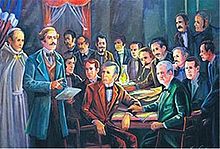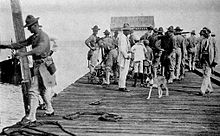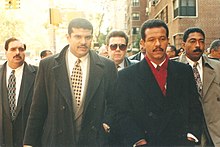The Taínos
The Arawakan-speaking Taínos moved into Hispaniola from the north east region of what is now known as South America, displacing earlier inhabitants, c. AD 650. They engaged in farming and fishing, and hunting and gathering. The fierce Caribs drove the Taínos to the northeastern Caribbean during much of the 15th century. The estimates of Hispaniola's population in 1492 vary widely, including one hundred thousand, three hundred thousand, and four hundred thousand to two million. Determining precisely how many people lived on the island in pre-Columbian times is next to impossible, as no accurate records exist. By 1492 the island was divided into five Taíno chiefdoms.The Spaniards arrived in 1492. After initially friendly relationships, the Taínos resisted the conquest, led by the female Chief Anacaona of Xaragua and her ex-husband Chief Caonabo of Maguana, as well as Chiefs Guacanagaríx, Guamá, Hatuey, and Enriquillo. The latter's successes gained his people an autonomous enclave for a time on the island. Nevertheless, within a few years after 1492 the population of Taínos had declined drastically, due to smallpox, genocide, execution and other diseases that arrived with the Europeans, and from other causes discussed below. The last record of pure Taínos in the country was from 1864. Still, Taíno biological heritage survived to an important extent, due to intermixing. Census records from 1514 reveal that 40% of Spanish men in the colony had Taíno wives, and some present-day Dominicans have Taíno ancestry. Tainos were stated to be extinct in Hispanola as a result of genocide by the Spaniards. "By 1535, say the leading scholars on this grim topic for all practical purposes, the native population was extinct." Remnants of the Taino culture include their cave paintings, as well as pottery designs which are still used in the small artisan village of Higüerito, Moca.
Spaniard and French rule
The Taínos nearly disappeared, above all, from European infectious diseases to which they had no immunity. Other causes were abuse, suicide, the breakup of family, starvation, the encomienda system, which resembled a feudal system in Medieval Europe, war with the Spaniards, changes in lifestyle, and mixing with other peoples. Laws passed for the Indians' protection (beginning with the Laws of Burgos, 1512–1513) were never truly enforced. Some scholars believe that las Casas exaggerated the Indian population decline in an effort to persuade King Carlos to intervene, and that encomenderos also exaggerated it, in order to receive permission to import more African slaves. Moreover, censuses of the time omitted the Indians who fled into remote communities, where they often joined with runaway Africans (cimarrones), producing Zambos. Also, Mestizos who were culturally Spanish were counted as Spaniards, some Zambos as black, and some Indians as Mulattos.
Santo Domingo's population saw a spectacular increase during the 18th century, as it rose from some 6,000 in 1737 to about 125,000 in 1790. Approximately, this was composed of 40,000 white landowners, 25,000 black or mulatto freedmen, and 60,000 slaves.
After its conquest of the Aztecs and Incas, Spain neglected its Caribbean holdings. French buccaneers settled in western Hispaniola, and by the 1697 Treaty of Ryswick, Spain ceded the (now Haitian) area to France. France created a wealthy colony Saint-Domingue there, with a population – at the end of the 18th century – 90% enslaved and overall four times as numerous (500,000 vs 125,000) as the Spanish area (now Dominican).
France came to own the island in 1795, when by the Peace of Basel Spain ceded Santo Domingo as a consequence of the French Revolutionary Wars. At the time, Saint-Domingue's slaves, led by Toussaint Louverture, were in revolt against France. In 1801 they captured Santo Domingo, thus controlling the entire island; but in 1802 an army sent by Napoleon captured Toussaint Louverture and sent him to France as prisoner. However, Toussaint Louverture's lieutenants, and yellow fever, succeeded in expelling the French again from Saint-Domingue, which in 1804 the rebels made independent as the Republic of Haiti. Eastwards, France continued to rule Spanish Santo Domingo.
In 1805, Haitian troops of general Henri Christophe invaded Santo Domingo and sacked the towns of Santiago de los Caballeros and Moca, killing most of their residents and helping to lay the foundation for two centuries of animosity between the two countries.
Haitian rule
In 1808, following Napoleon's invasion of Spain, the criollos of Santo Domingo revolted against French rule and, with the aid of Great Britain (Spain's ally) and Haiti, returned Santo Domingo to Spanish control.
Juan Pablo Duarte is widely considered the
architect of the Dominican Republic and its independence from Haitian rule in 1844.
As Toussaint Louverture had done two decades earlier, the Haitians abolished slavery. They also nationalized most private property, including all the property of landowners who had left in the wake of the invasion; much Church property; as well as all property belonging to the former rulers, the Spanish Crown. Boyer also placed more emphasis on cash crops grown on large plantations, reformed the tax system, and allowed foreign trade. The new system was widely opposed by Dominican farmers, although it produced a boom in sugar and coffee production. All levels of education collapsed; the university was shut down, as it was starved both of resources and students, with young Dominican men from 16 to 25 years old being drafted into the Haitian army. Boyer's occupation troops, who were largely Dominicans, were unpaid, and had to "forage and sack" from Dominican civilians. Haiti imposed a "heavy tribute" on the Dominican people. Many whites fled Santo Domingo for Puerto Rico and Cuba (both still under Spanish rule), Venezuela, and elsewhere. In the end the economy faltered and taxation became more onerous. Rebellions occurred even by Dominican freedmen, while Dominicans and Haitians worked together to oust Boyer from power. Anti-Haitian movements of several kinds – pro-independence, pro-Spanish, pro-French, pro-British, pro-United States – gathered force following the overthrow of Boyer in 1843.:page number needed
Independence
The decades that followed were filled with tyranny, factionalism, economic difficulties, rapid changes of government, and exile for political opponents. Threatening the nation's independence were renewed Haitian invasions occurring in 1844, 1845–49, 1849–55, and 1855–56.
Meanwhile, archrivals Santana and Buenaventura Báez held power most of the time, both ruling arbitrarily. They promoted competing plans to annex the new nation to another power: Santana favored Spain, and Báez the United States.
Restoration republic
Political strife again prevailed in the following years; warlords ruled, military revolts were extremely common, and the nation amassed debt. It was now Báez's turn to act on his plan of annexing the country to the United States, where two successive presidents were supportive. U.S. President Grant desired a naval base at Samaná and also a place for resettling newly freed Blacks. The treaty, which included U.S. payment of $1.5 million for Dominican debt repayment, was defeated in the United States Senate in 1870 on a vote of 28–28, two-thirds being required.
"Lilís", as the new president was nicknamed, enjoyed a period of popularity. He was, however, "a consummate dissembler", who put the nation deep into debt while using much of the proceeds for his personal use and to maintain his police state. Heureaux became rampantly despotic and unpopular. In 1899 he was assassinated. However, the relative calm over which he presided allowed improvement in the Dominican economy. The sugar industry was modernized, and the country attracted foreign workers and immigrants.
20th century
From 1902 on, short-lived governments were again the norm, with their power usurped by caudillos in parts of the country. Furthermore, the national government was bankrupt and, unable to pay Heureaux's debts, faced the threat of military intervention by France and other European creditor powers.U.S. President Theodore Roosevelt sought to prevent European intervention, largely to protect the routes to the future Panama Canal, as the canal was already under construction. He made a small military intervention to ward off the European powers, proclaimed his famous Roosevelt Corollary to the Monroe Doctrine, and in 1905 obtained Dominican agreement for U.S. administration of Dominican customs, then the chief source of income for the Dominican government. A 1906 agreement provided for the arrangement to last 50 years. The United States agreed to use part of the customs proceeds to reduce the immense foreign debt of the Dominican Republic, and assumed responsibility for said debt.
After six years in power, President Ramón Cáceres (who had himself assassinated Heureaux) was assassinated in 1911. The result was several years of great political instability and civil war. U.S. mediation by the William Howard Taft and Woodrow Wilson administrations achieved only a short respite each time. A political deadlock in 1914 was broken after an ultimatum by Wilson telling Dominicans to choose a president or see the U.S. impose one. A provisional president was chosen, and later the same year relatively free elections put former president (1899–1902) Juan Isidro Jimenes Pereyra back in power. To achieve a more broadly supported government, Jimenes named opposition individuals to his Cabinet. But this brought no peace and, with his former Secretary of War Desiderio Arias maneuvering to depose him and despite a U.S. offer of military aid against Arias, Jimenes resigned on May 7, 1916.
But the occupation regime, which kept most Dominican laws and institutions, largely pacified the country, revived the economy, reduced the Dominican debt, built a road network that at last interconnected all regions of the country, and created a professional National Guard to replace the warring partisan units.
Opposition to the occupation continued, however, and after World War I it increased in the U.S. as well. There, President Warren G. Harding (1921–23), Wilson's successor, worked to end the occupation, as he had promised to do during his campaign. U.S. government ended in October 1922, and elections were held in March 1924.
The victor was former president (1902–03) Horacio Vásquez Lajara, who had cooperated with the U.S. He was inaugurated on July 13, and the last U.S. forces left in September. Vásquez gave the country six years of good government, in which political and civil rights were respected and the economy grew strongly, in a peaceful atmosphere.
There was considerable economic growth during Trujillo's long and iron-fisted regime, although a great deal of the wealth was taken by the dictator and other regime elements. There was progress in healthcare, education, and transportation, with the building of hospitals and clinics, schools, and roads and harbors. Trujillo also carried out an important housing construction program and instituted a pension plan. He finally negotiated an undisputed border with Haiti in 1935, and achieved the end of the 50-year customs agreement in 1941, instead of 1956. He made the country debt-free in 1947.
This was accompanied by absolute repression and the copious use of murder, torture, and terrorist methods against the opposition. Trujillo renamed Santo Domingo to "Ciudad Trujillo" (Trujillo City), the nation's – and the Caribbean's – highest mountain La Pelona Grande (Spanish for: The Great Bald) to "Pico Trujillo" (Spanish for: Trujillo Peak), and many towns and a province. Some other places he renamed after members of his family. By the end of his first term in 1934 he was the country's wealthiest person, and one of the wealthiest in the world by the early 1950s; near the end of his regime his fortune was an estimated $800 million.
In 1937 Trujillo (who was himself one-quarter Haitian), in an event known as the Parsley Massacre or, in the Dominican Republic, as El Corte (The Cutting), ordered the Army to kill Haitians living on the Dominican side of the border. The Army killed an estimated 17,000 to 35,000 Haitians over six days, from the night of October 2, 1937 through October 8, 1937. To avoid leaving evidence of the Army's involvement, the soldiers used machetes rather than bullets. The soldiers of Trujillo were said to have interrogated anyone with dark skin, using the shibboleth perejil (parsley) to tell Haitians from Dominicans when necessary; the 'r' of perejil was of difficult pronunciation for Haitians. As a result of the massacre, the Dominican Republic agreed to pay Haiti US$750,000, later reduced to US$525,000.
On November 25, 1960 Trujillo killed three of the four Mirabal sisters, nicknamed Las Mariposas (The Butterflies). The victims were Patria Mercedes Mirabal (born on February 27, 1924), Argentina Minerva Mirabal (born on March 12, 1926), and Antonia María Teresa Mirabal (born on October 15, 1935). Minerva was an aspiring lawyer who was extremely opposed to Trujillo's dictatorship since Trujillo had begun to make rude sexual advances towards her. The sisters have received many honors posthumously, and have many memorials in various cities in the Dominican Republic. Salcedo, their home province, changed its name to Provincia Hermanas Mirabal (Mirabal Sisters Province). The International Day for the Elimination of Violence against Women is observed on the anniversary of their deaths.
For a long time, the US and the Dominican elite supported the Trujillo government. This support persisted despite the assassinations of political opposition, the massacre of Haitians, and Trujillo's plots against other countries. The US believed Trujillo was the lesser of two or more evils. The U.S. finally broke with Trujillo in 1960, after Trujillo's agents attempted to assassinate the Venezuelan president, Rómulo Betancourt, a fierce critic of Trujillo. Trujillo was assassinated on May 30, 1961.
In February 1963, a democratically elected government under leftist Juan Bosch took office but was overthrown in September. In April 1965, after 19 months of military rule, a pro-Bosch revolt broke out. Days later, U.S. President Lyndon Johnson, concerned that Communists might take over the revolt and create a "second Cuba", sent the Marines, followed immediately by the Army's 82nd Airborne Division and other elements of the XVIIIth Airborne Corps in Operation Powerpack. "We don't propose to sit here in a rocking chair with our hands folded and let the Communist set up any government in the western hemisphere", Johnson said. The forces were soon joined by comparatively small contingents from the Organization of American States. All these remained in the country for over a year and left after supervising elections in 1966 won by Joaquín Balaguer, who had been Trujillo's last puppet-president.
Balaguer remained in power as president for 12 years. His tenure was a period of repression of human rights and civil liberties, ostensibly to keep pro-Castro or pro-communist parties out of power. His rule was further criticized for a growing disparity between rich and poor. It was, however, praised for an ambitious infrastructure program, which included large housing projects, sports complexes, theaters, museums, aqueducts, roads, highways, and the massive Columbus Lighthouse, completed in a subsequent tenure in 1992.
Recent history
In 2000 the PRD's Hipólito Mejía won the election. This was a time of economic troubles, and Mejía was defeated in his re-election effort in 2004 by Fernández, who won re-election in 2008. Fernández and the PLD are credited with initiatives that have moved the country forward technologically, such as the construction of the Metro Railway ("El Metro"). On the other hand, his administrations have also been accused of corruption.[70] Danilo Medina of the same PLD party was elected president in 2012 under the promise of investing more on social programs and education and less on infrastructure.







